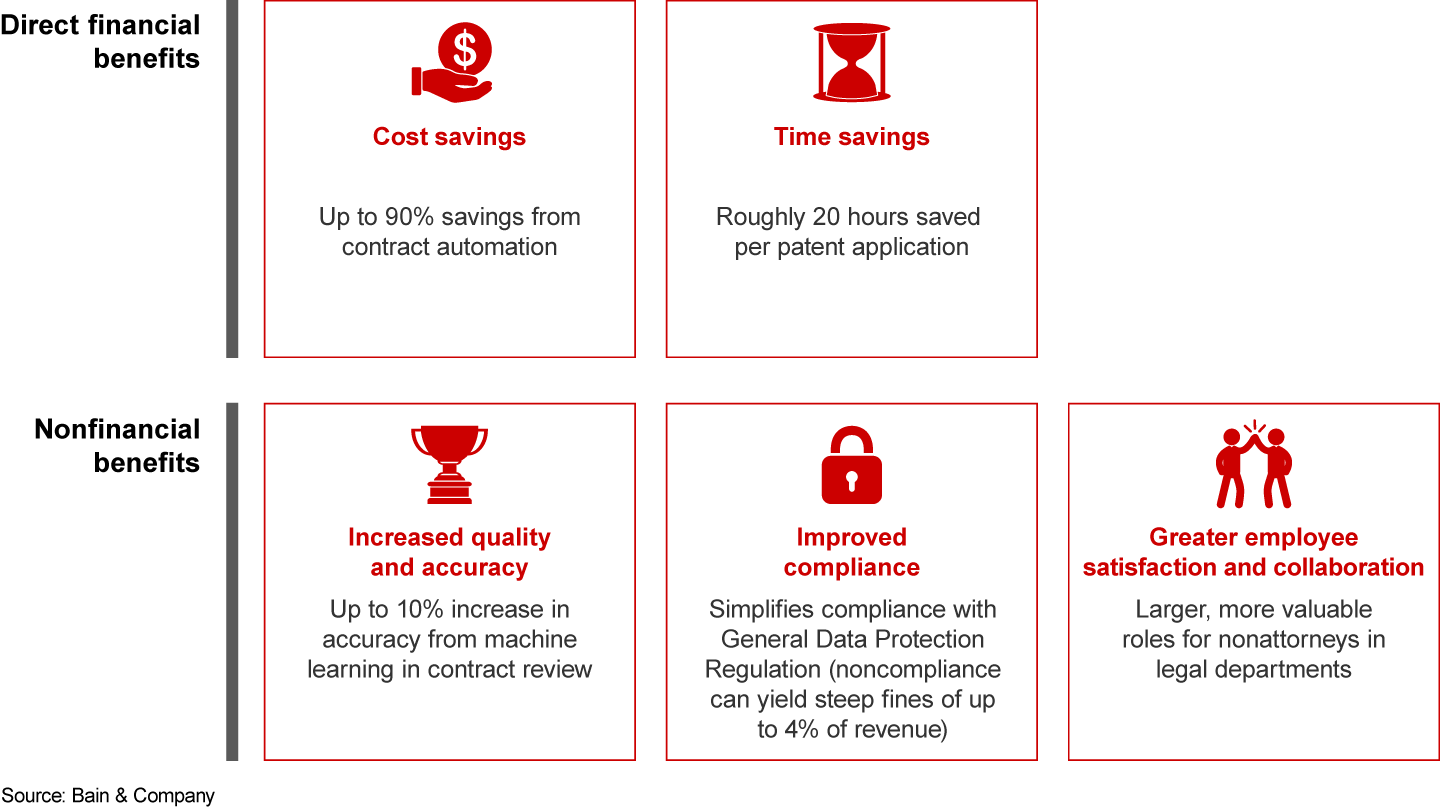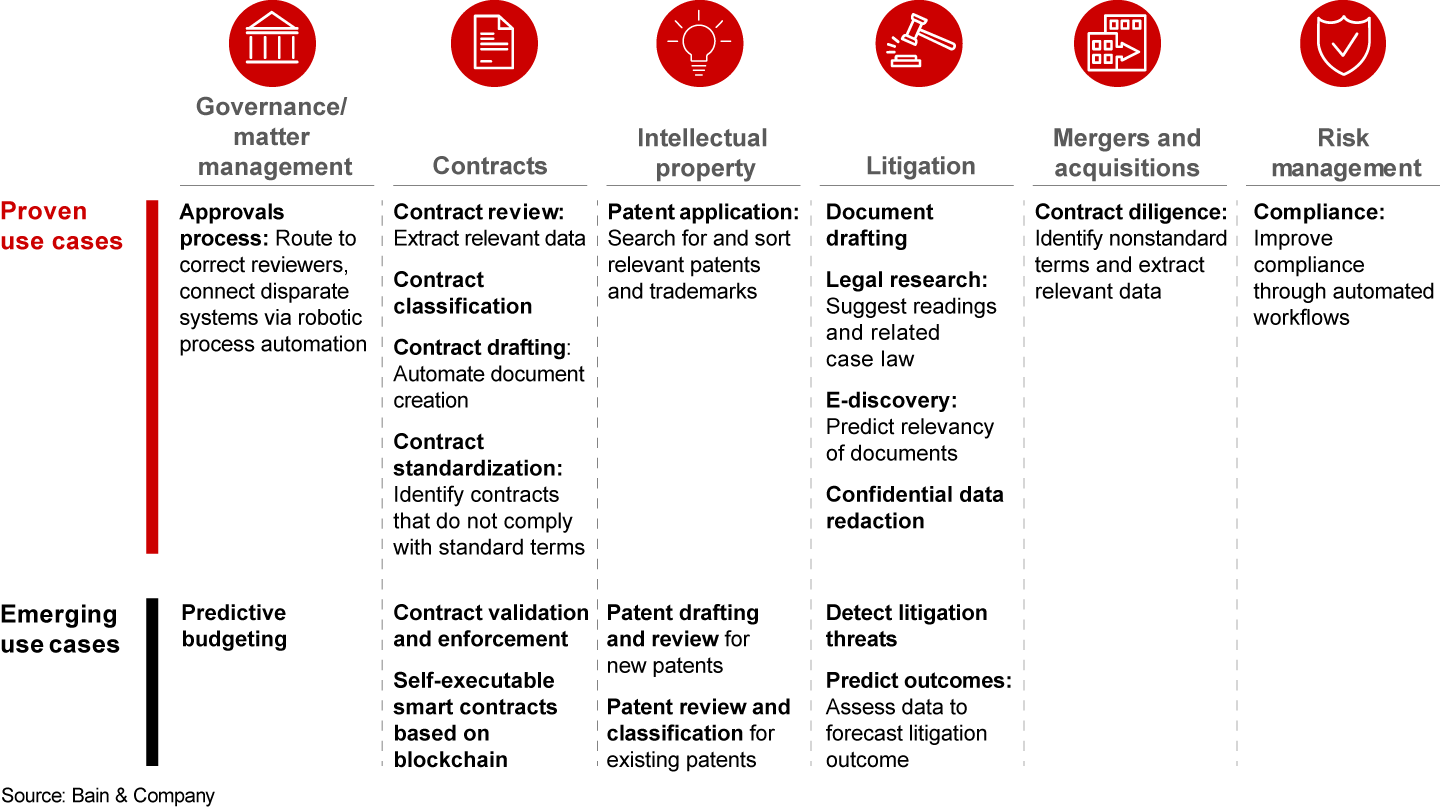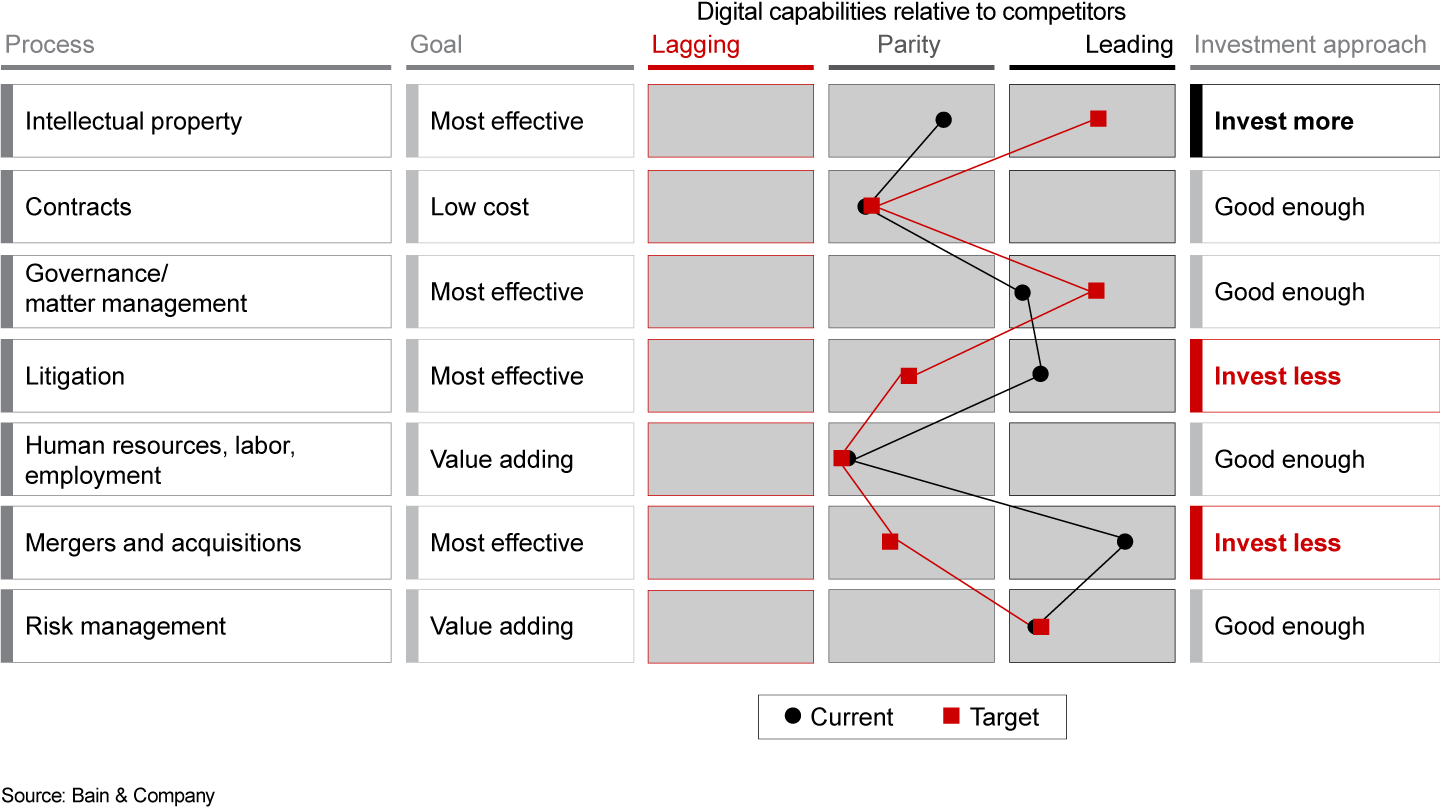Etude

En Bref
- Legal’s internal customers increasingly expect high-quality, convenient, fast and low-cost support.
- New digital technologies, especially artificial intelligence, offer tools to raise legal’s value to the business in workflow speed, accuracy and responsiveness.
- Yet legal still lags other functions, such as human resources and finance, in the adoption of artificial intelligence.
- A path to accelerated digital adoption involves identifying the biggest opportunities, investing in a portfolio of digital bets, and testing and learning to continually improve the experience.
One of the last places you would expect to hear the siren call of the Airbnb or WeChat consumer experience is in a corporate legal department. But as powerful experiences spread from consumer markets to companies’ internal work, a legal department’s internal customers now have similar expectations for convenience, simplicity, speed and low cost.
Digital technologies are essential ingredients for meeting those expectations. While legal departments often adopt digital technologies to lower costs, the most transformative effect will be on the experience that legal provides to internal business customers. Notably, digital adoption can simplify and speed up work that previously required hours of manual review by lawyers, paralegals and other legal staff.
Artificial intelligence (AI) is among the most promising technologies, and forward-thinking legal groups in a range of industries have embraced it. Many legal teams are hungry for the opportunity to gain an edge over the competition, and AI is one of those rare technologies that can further that mission.
JPMorgan Chase’s legal team, for instance, used to review commercial loan agreements manually. Starting in 2017, JPMorgan built Coin (Contract Intelligence), an AI engine to automate legal work that cut up to 360,000 hours of agreement review by lawyers and loan officers each year. Now, the company is rolling out Coin on other complex legal processes, such as reviewing credit default swaps and custody agreements.
At Coca-Cola, AI-based tools have sped up contract drafting and reduced the amount of time that lawyers had been spending on review. Coca-Cola launched a self-service portal that reduced contract-drafting time for many matters from up to 10 hours to around 15 minutes. These tools also reduce risk and improve efficiency by creating consistency in agreements—and they free up the legal team to focus on more strategic and value-added work.
By allowing accelerated digital processes to take the place of manual busywork for many routine legal matters, the department can then focus on the tasks that further business objectives. Moreover, AI allows companies to automate many internal processes, which, in turn, accelerates workflow and decision making throughout the organization.
Still lagging other functions
Yet legal is lagging some other corporate functions in this regard. Only 20% to 25% of legal departments use AI in at least one area, according to a LexisNexis survey of legal departments, compared with 40% in finance and 54% in human resources, recent Bain & Company surveys found. And looking two years out, finance and HR expect to adopt AI much more aggressively than legal. That’s consistent with new research by Gartner, which found that 8 in 10 corporate legal departments are unprepared to support their organizations’ digital initiatives.
What accounts for legal’s relatively slow adoption? Some chief legal officers (CLOs) are concerned about increased risks that come with using AI. In multiple tests, however, AI has outperformed lawyers on certain workflows. According to a study by LawGeex, reviewing a set of five typical nondisclosure agreements (NDAs) takes lawyers an average of 92 minutes, with 85% accuracy, while machine learning takes 26 seconds, with 94% accuracy. CLOs may also be skeptical of the return on investment for digital tools in certain areas, but early use of AI adoption has shown promise as it quickly moves from the early adopter phase to maturity in large legal departments. Finally, some CLOs are wary of asking for significant investment, but if they make the right case, legal teams can support the investment based on cost savings and improved workflow experience for internal customers.
To be sure, AI still gets a lot of hype from vendors and the technology media, but plenty of cases have delivered substantial business value (see Figure 1). The benefits include the following:
- up to 90% savings from contract automation;
- documented cases of up to 20 hours saved per patent application;
- immediate savings of 4% to 8% by using machine learning and natural language processing to automate reviews of outside counsel invoices, which spots errors and noncompliance with billing rules;
- simplified compliance procedures for General Data Protection Regulation and other important regulations; and
- less quantifiable but equally important, AI can yield greater employee satisfaction and more value-added roles for lawyers and other legal staff.


AI’s uses in the legal realm are still being defined, with some more proven than others (see Figure 2). For instance, predictive insights about the likelihood of litigation makes for better informed business decisions. Software can spot and mitigate risks in business processes. AI provides faster, less expensive means to deal with e-discovery, compliance monitoring and e-billing. And with AI still in early stages, the potential value of digital tools will only grow.


Consider how Liberty Mutual, a 106-year-old insurer, has steadily modernized its legal operations to support the business and handle its large litigation and claims portfolio. Liberty Mutual developed automated dashboards for legal and implemented both predictive and prescriptive analytics. For example, software now alerts legal when a particular case resembles other cases, speeding up review and supporting more informed risk management. Legal also installed a digital document management repository to ensure controls on sensitive documents. Finally, Liberty Mutual set up a group that regularly brainstorms ideas and possible digital projects for the legal department, and hosts two vendor days each year to explore new digital opportunities.
Liberty Mutual’s yearslong digital transition has been much broader than the legal department, but legal has been a full participant in a companywide initiative to embrace technology to enhance customers’ experience externally and internally. Technology has also changed Liberty Mutual’s organization and culture. Even within the legal function, dedicated data scientists actively focus on digital opportunities that will benefit the department.
Turning digital hype into practical reality
Leaders of legal groups committed to accelerating their digital journey need to find a practical path that balances digital opportunities with the realities of the maturity of the technology, investment budgets and the cultural transformation required. The path consists of a measured but fast-paced sequence that department leadership will embrace.
Think big. A digital vision should be ambitious, though it can build on prior successes. For example, legal could aspire to reduce manual reviews of NDAs by 80%, or to accelerate contract or distribution agreements. It could also aim for a streamlined digital management of employee litigation and disputes, as well as policy compliance.
Select your battles carefully. To avoid chasing the next shiny object, set digital goals based on the business’s strategic and operational objectives. Then assess the legal department’s digital readiness against those goals, as well as against competitors and other leading companies. To determine where to invest more and where to invest less, identify the investments that will move your organization closer to its business objectives (see Figure 3).


Think process. Digital technology only yields value when an organization embeds it into the workflow, directly with customers throughout the business. For instance, the same handful of issues typically crop up in any NDA form, such as the expiration of confidentiality or clauses related to venue or arbitration. A convenient digital process would allow a user to pull down the preapproved form and send it out without intervention from a lawyer. If it comes back with a couple of changes requested, a well-trained AI bot can pick up the changes and respond; only exceptions to exceptions would need to go to a paralegal or lawyer. Rather than digitizing broken or inefficient processes, it’s generally better to fix and simplify them before digitization.
Assemble a portfolio of digital bets. Your portfolio could include three types of bets. First, as a baseline, don’t neglect tried-and-true technologies, such as automated drafting of routine high-volume contracts or platforms for e-billing. Next, explore more ambitious bets that could help your company gain a competitive advantage, such as forecasting litigation costs and outcomes using predictive analytics, improving compliance through automated workflows, or making the contracting process quick and easy. For instance, insurance companies used to face criticism for their impossibly dense contracts—that is, until some insurers figured out how to sell policies online in minutes with simplified forms and contracts. Finally, check out a few bets that could put the firm at the leading edge, such as self-executing smart contracts via blockchain or machine learning to value large intellectual property portfolios.
Build up your capabilities. The biggest gap in making AI work often lies in a firm’s capabilities. For example, a machine-learning algorithm only works as well as the quality of the data. These algorithms may need a monthly, daily or even real-time refresh of data to work well. Without addressing data governance and quality, algorithms have limited value.
Change behavior accordingly. In our experience, behavior change often is more challenging than making the technology work or finding the funds for investment. It’s critical to win over legal’s internal business customers and sometimes even external customers, suppliers and other partners. The IT group should be involved from the start, rather than finding a technology and then forcing IT to implement it. Moreover, behavior change hinges on strong sponsorship by the CLO and chief information officer, both of whom can reinforce the message that digital investment in legal accelerates business objectives. Finally, unless people are adequately prepared, briefed and trained, the program will fail. Take a cue from consumer markets by doing iterative testing and learning on pilot projects that include feedback from internal customers.
Legal’s internal customers are demanding faster, higher-quality advice and service at a reasonable cost. Careful selection of the appropriate digital tools from an ever-expanding kit, combined with continual upgrades of the technical and analytics skills of the legal team and a thoughtful approach to behavior change, will help raise legal’s strategic value to its business partners.
Michael Heric is a partner with Bain & Company’s Performance Improvement practice. Michael leads the firm’s support functions work globally, and he is based in New York. Neal Goldman is a legal management adviser to Bain, and he is based in Boston.